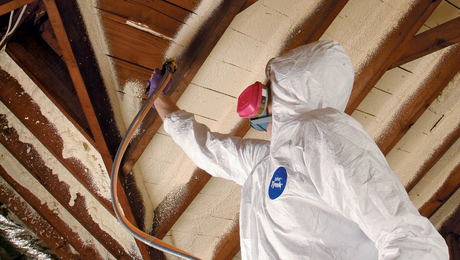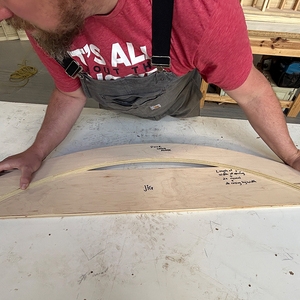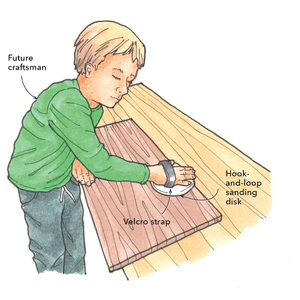*
i am building a two story and am considering locating the laundry room on the second floor. It just seems to make sense, because thats where the laundry is. Now i have searched the archives and have not really found to much, so i thought i might pose the question again. What are the pros and cons and what type of prep should/could be done before hand to make this a successful idea. Or tell me this is one of those ideas that only looks good on the blueprint.
Discussion Forum
Discussion Forum
Up Next
Video Shorts
Featured Story

Spray foam is a great invention, but it's not always necessary.
Featured Video
Builder’s Advocate: An Interview With ViewrailHighlights
"I have learned so much thanks to the searchable articles on the FHB website. I can confidently say that I expect to be a life-long subscriber." - M.K.
Fine Homebuilding Magazine
- Home Group
- Antique Trader
- Arts & Crafts Homes
- Bank Note Reporter
- Cabin Life
- Cuisine at Home
- Fine Gardening
- Fine Woodworking
- Green Building Advisor
- Garden Gate
- Horticulture
- Keep Craft Alive
- Log Home Living
- Military Trader/Vehicles
- Numismatic News
- Numismaster
- Old Cars Weekly
- Old House Journal
- Period Homes
- Popular Woodworking
- Script
- ShopNotes
- Sports Collectors Digest
- Threads
- Timber Home Living
- Traditional Building
- Woodsmith
- World Coin News
- Writer's Digest


















Replies
*
lou - Use the Floodsaver or create a pan of your own - it's a must for second floor use. Other issues are hose bursting (use stainless braided and a special automatic shutoff valve) and vibration.
Jeff
*Hi Lou - I moved my laundry up to a second floor closet. I installed a floor drain and carefully caulked around the baseboards to minimize damage if a leak occurs. Use stainless hoses as Jeff mentioned.Your wife will love you for it.
*Jeff: More on the automatic shutoff? Is this for laundry room only, or whole house? Thanks.
*We installed a washer/dryer in a second floor closet. It is great. One thing to check on, our local plumbing inspector would only allow us to install a gas dryer if we also installed a 4" round opening to the outside. The opening could not have any damper or louver either. He required this because there were sleeping rooms on the floor, and worries of backdrafting bringing in CO or other combustables. Frankly, with a 3 year old in the next room, I was easy to convince. Needless to say here in New England a 4" opening to the outside was not going to fly, so we opted for an electrc dryer. So you might want to check with your local inspector....
*Hi-Right or wrong, think about noise reverberated thru the floor and down to the levels below, what type of rooms are under where the laundry would be located, etc. Washing machines on spin cycle on the second floor may not sound good to the person in a study or bedroom located underneath it... and the noise may echo thru the floor joists all over the house...Personally, I wouldn't do it...
*I retrofit them all the time.Use tile as a finish floor. From subfloor up, use roofing cement, tar paper, deck mud (or duroc) then tile. If you want to be extra carefull, consider CPE or a PVC liner under deck mud (or a trowel applied waterproofing mat over the duroc).Add a floor drain. Some codes require it to have a primer. The washer overflow tubs may or may not hold a full washer load of water. Indeed, if a hose breaks, no waher overflow tub will hold a continual stream of water for 8 hours until you discover it. That is why I would recommend tile and a floor drain. Dryer exhaust can be a problem if the location is in an interior room and your dryer hose run is over 8 feet. Contact FanTech http://www.fantech-us.com/dryer_boosting.htmto obtain information on booster fans. They work great.Consider an exhaust fan, too, because the room will generate some heat and moisture not withstanding the dryer exhaust fan. FanTech has those as well.Of course, plenty of storage, a drop down ironing board, overhead cabinets and undercounter lighting and space for hampers. A table or countertop to fold clothes is always a nice touch.
*My house has the washer and dryer in an upstairs closet where all the bedrooms are. It is the best thing about this house and saves a tremendous amount of work. It would be even better if it were located in a whole room as Scooter suggests. After all, the vast majority of the laundry is located in the bedrooms. The only reason it is traditionally located in or near the kitchen is because in the days of dedicated housewives, the laundry would be near the water source and where said housewife would be spending most of her time. That is no longer the case in modern lifestyles. The hardest part was getting the appliances up the stairs. Go for it.Mary
*We have stackable units in our master closet and it saves a lot of schlepping laundry up and down and stairs. What ever hoses you go with, I'd replace them every few years. Even though they often last for 10 or more years, $10 for a new pair is cheap insurance. I think the automatic valves mentioned earlier were featured in a FHB about 6 months ago. The prevent a burst hose from continuing to leak water.I haven't found the noise to be any problem. If we have just put the baby down in the next room, we don't start it up. But once he's asleep, even the spin cycle is okay.If you have a gas dryer (which is far cheaper to operate and takes half the time to dry clothes), you have to make provision for combustion air. This could be a connection to a hallway or vents in whatever door is on the washer/dryer closet. Electric dryers move air too although not as much. So you don't want a tight fitting door for an electric dryer either.I really like our front-loading clothes washer. It uses less water, less detergent, and is much gentler on the clothes. Now that there are domestic ones available, they don't cost much more than top loaders. Also easier to use in a stacked configuration. Jeff: Why will his wife love it? Maybe Lou does all the laundry. I do. -David
*Could anyone describe the best fittings and configuration for a floor drain? I'm redoing a laundry at the moment, and couldn't find something that would be easy to screw down to the subfloor and then adapt to ABS. Also, I thought about not installing a trap since the drain will end up being located under the washer. Any thoughts? Thanks, QED.
*I give a huge Amen to all the hose warnings. If I had these warning a few years ago, would have saved me a lot of money for repairs.Also, place the shutoff faucets where they are easily reached. My wife was home when the hose blew, but it was the hot water hose, and she couldn't reach the faucet without putting her hand in the stream of water. She had to wait for the water heater to stop supplying hot water to even begin trying to turn it off.Dave
*I do NOT recommend residential floor drains unless at least a deep seal trap is used. Standard traps dry out and then, well, that really stinks.The whole-house auto shut-off should be in the archives and, I believe, they advertise in FHB.Jeff
*We did the laundry on the 1st floor in reasonable proximity to family room. Why? Our family is young and growing. Wife didn't want to leave a couple of toddlers downstairs by themselves while she went upstairs to load laundry. We have a laundry shoot to go down, but we do have to manually carry back up. Also, we avoid vibration and failure issues. If your kids are older, it may be less an issue. Also, think about WHEN you run laundry, and what the laundry would be near.
*> I do NOT recommend residential floor drains unless at least a deep seal trap is used. As this is an emergency flood mitigation type of drain, does it need to be tied to the sewer, or could it just run to daylight with no trap, like a Smitty pan for a water heater? What's code on this? Also, what does code say about venting for a floor drain? You may have a rather long horizontal run from the middle of a floor to the nearest place where you can put a vertical vent pipe.-- J.S.
*john is on the right track..laundry in proximity to the bedrooms is one of the greatest labor savers in the house.. and , as stated , traps dry out.. so run the emergency floor drain to daylight.. it will probably never be used. so don't connect it to the sewer..the emergency floor drain can also function as a combustion air source if you have a gas dryer...we've had our laundry on the 2d floor in our last 3 houses.... since 1979...no floods..lots of schlepping saved...make sure the closet is big enough to get the equipment in and out.. and deep enough to accomodate the dryer vent & washer hoses...side-by-side.. most units will go thru a 5' door with the doors off...
*We did one last fall and used a valve shown here.http://www.plumbingsupply.com/washingmachineshutoffvalve.htmlIt is a way-cool valve that only pressurizes the hoses while the washing machine is in use. The homeowner (wife in this case) has told me at least three times that we are heroes for this job. Her only complaint was the noise. You can hear the machines running downstairs in the kitchen. The washer and dryer were placed on a sheet vinyl floor over the 3/4" subfloor.
*A drain primer prevents the trap from drying out and is code here in SoCal. It is a 1/2" fitting in which a shutoff valve is connected on the wall and set so it drips ever so slightly and keeps the trap wet. You must install a trap here, so there is a water barrier to prevent sewer gas. Not installing one is crazy, and asking for trouble. As for a floor drain, I use nothing but InstaSet fitting, you know the blue kind. They are super heavy duty and absolutely the best plumbing draines, toilet flanges etc. Cast iron, baby!!
*Scooter,thanks for the input and i have a question for you. With the floor you are describing, how is the sound transfer?(mainly to the floor below, which is my kitchen) Is there anyway to create a good buffer?Rubber mats maybe?
*Please watch out for the drain hose as well. The moron that I let install my new washer used stainless hoses for the hot & cold, but failed to strap down the outlet hose in the drain properly.The overflow happened on the very first day of moving into our new house. Ruined the floor (drain pan couldn't handle the volume), baseboards, carpet in hall, ceiling on first floor, Lay-Z-Boy, endtable, couch, crown moulding, carpet on first floor, rusted the return plenum in the HVAC system, rusted the HVAC vents, shorted out the dining room light, ceiling fan in den, etc.I sold that damn place a year later after I got everything fixed/replaced.
*I just built a house and made my laundry room on the second floor. I tiled the floor the same way I did my shower floor with a floor drain. Caulked the base molding with silicone to the floor tiles. I'm guessing it'll never have to be used but its there non the less. Its fantastic having the laundry room with most of the bedrooms.
*If you're really concerned about vibration transfer to the rest of the building, maybe build it like a projection booth floor. Give it its own separate foundation and reinforced concrete structure all the way to the floor. We have to do that in really big theaters to keep the picture from shaking, unless the whole structure is reinforced concrete.-- J.S.
*I think FloodSaver mentioned something about using a bit of mineral oil in the trap to stop the water from evaporating.
*I guess I'll have to go against the flow here. We are building a new house and after four years of having the laundry on the second floor in our old house, we are putting it on the first floor in a mud room off the kitchen. This is my wife's choice and since she does the laundry I have to let her put it where she wants. (I'm not allowed to do laundry ever since I shrunk her red sweater and turned all the whites pink in the process. Actually it was a well-planned move on my part ;) Her reasoning is that she spends most of the day downstairs and in our old house it was a pain to have to go upstairs to do the laundry. She feels that having the washer/dryer right off the kitchen and main living area will make her life easier. I do know that having the laundry on the second floor was really loud and caused a lot of vibration. We have a wall clock that we couldn't keep running because the vibration from the spin cycle would actually stop the pendulum. If I were ever going to put the laundry on the second floor I would be sure the framing/floor system would be sturdy enough to cut out the noise and vibration.
*Main floor mud-room/laundry room with laundry chute in upstairs bath.
*We ran the laundry emergency drain straight to daylight ending just above the rain gutter above the 1st floor. Same with the water heater on the 2nd floor which is in the attic behind the laundry. Tile floor in the laundry, no serious noise problems.
*We remodeled a beach home with the laundry on the second floor. The homeowners had us install a dumb waiter that opened into the laundry room because it was too taxing to carry the supplies (detergent, bleach, softener) up the stairs, as well as the other dirty stuff from the ground floor (kitchen, full bath, garage/garden).
*I'm in the process of remodeling a second floor bathroom and moving the laundry up to it. Though I plan to buy a new, quiet washer, I've been toying with ideas on constructing an additional vibration reducing pad/floor on top of the new floor to set the washer and dryer on. Anyone have any thoughts on what, if anything, might work?Also, I've been debating installing one of these shutoff valves, mentioned earlier in this thread (Watts Intelliflow Automatic No. 2). http://www.plumbingsupply.com/washingmachineshutoffvalve.htmlAt least in theory, this looks like a much better safety solution than floor drains and Floodsavers. Anyone else have experience with these things?
*The Watts system only protects against the supply hose breaking while the washer is not in use.It does nothing to protect against the hose breaking while in use (but with pressure off most of the time this is much less likely) or the tub leaking (which can have a small leak for a long time before it is detected) or the drain overflowing.
*the only real drawback to a second story laundry is that laundry chutes only go down.Maybe you could move to Australia, I heard gravity is backwards down under ;<}
*Definitely daylight the emergency overflow drain. It is required for a gas dryer too, in case there is a gas leak.
*> I've been toying with ideas on constructing an additional vibration reducing pad/floor on top of the new floor to set the washer and dryer on. Anyone have any thoughts on what, if anything, might work? Short of an independent structure all the way to the ground, the next best thing would be to decrease the amplitude of the vibration by giving the machines lots of mass to have to shake. A tile floor on a mortar bed would help a lot.-- J.S.
*Second-floor baths are quite common these days. To me, they make total sense.Always tiled. I put a rubber mat down, then a sheet of durock, then the Floodsaver (or equivalent) pan. Then another small square of rubber mat goes under each foot of the washer. All that does a good job of quieting down even unbalanced spins.Here, the flood drains are never tied in to the sewer or septic, so there's no trap to worry about. The drain pipe is usually run to the basement where it drains, or it's tee'd off and brought outside to daylight.Definitely use braided hoses. Definitely use a shutoff valve, either manual or electric. If you want to go all the way, install a puddle/spill sensor. It senses water on the floor and snaps the supply valves closed.Much better than the either the electric or manual shutoff if you're that paranoid.
*
i am building a two story and am considering locating the laundry room on the second floor. It just seems to make sense, because thats where the laundry is. Now i have searched the archives and have not really found to much, so i thought i might pose the question again. What are the pros and cons and what type of prep should/could be done before hand to make this a successful idea. Or tell me this is one of those ideas that only looks good on the blueprint.